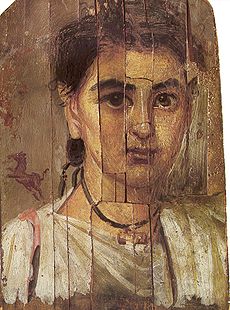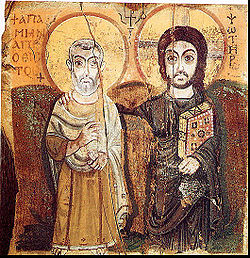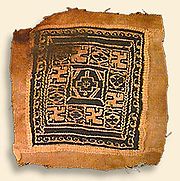
Coptic art
Encyclopedia




Illuminated manuscript
An illuminated manuscript is a manuscript in which the text is supplemented by the addition of decoration, such as decorated initials, borders and miniature illustrations...
s, and metalwork, much of which survives in monasteries and churches. The artwork is often functional, as little distinction was drawn between artistry and craftsmanship, and includes tunics and tombstones as well as portraits of saints.
The Coptic Museum
Coptic Museum
The Coptic Museum is a museum in Coptic Cairo, Egypt with the largest collection of Egyptian Christian artifacts in the world. It was founded by Marcus Simaika Pasha in 1910 to house Coptic antiquities. The museum traces the history of Christianity in Egypt from its beginnings to the present day...
in Coptic Cairo
Coptic Cairo
Coptic Cairo is a part of Old Cairo which encompasses the Babylon Fortress, the Coptic Museum, the Hanging Church, the Greek Church of St. George and many other Coptic churches and historical sites. It is believed that the Holy Family visited this area and stayed at the site of Saints Sergius and...
houses some of the world's most important examples of Coptic art and iconography.
Origins
Coptic art displays a mix of native Egyptian and Hellenistic influences. Subjects and symbols were taken from both Greek and Egyptian mythology, sometimes altered to fit Christian beliefs. Persia and Syria also influenced Coptic art, though to a lesser extent, leaving images such as the peacock and the griffin.Iconography
Coptic icons have their origin in the Hellenistic art of Egyptian Late Antiquity, as exemplified by the Fayum mummy portraitsFayum mummy portraits
Mummy portraits or Fayum mummy portraits is the modern term given to a type of naturalistic painted portraits on wooden boards attached to mummies from the Coptic period. They belong to the tradition of panel painting, one of the most highly regarded forms of art in the Classical world...
. The faces of El Fayum are examples of the Coptic art in the 2nd century AD showing the Greek and Roman influence on the Coptic art but with some distinctive features related to Egyptian art
The Arabic conquest of Egypt allowed the Coptic art to influence the Islamic art and architecture with many features that are now integral in the Islamic art.
Beginning in the 4th century, churches painted their walls and made icons to reflect an authentic expression of their faith.
The figures of saints display eyes and ears larger in proportion to the rest of the face and a smaller mouth, as well as enlarged heads, signifying a spiritual relationship with God and devotion to prayer. Martyrs' faces were peaceful.
Many Coptic iconographers did not sign their names, but the prominent among them include St. Luke
Luke the Evangelist
Luke the Evangelist was an Early Christian writer whom Church Fathers such as Jerome and Eusebius said was the author of the Gospel of Luke and the Acts of the Apostles...
(traditionally believed to be the first icon
Icon
An icon is a religious work of art, most commonly a painting, from Eastern Christianity and in certain Eastern Catholic churches...
painter) and two Coptic Popes, Pope Macarius I and Pope Gabriel III
Pope Gabriel III of Alexandria
Pope Gabriel III of Alexandria was the Coptic Pope of Alexandria and Patriarch of the See of St. Mark Number 78 .He was originally one of the candidates for the Papal post when Pope John VII was elected. With support from some of the Bishops, Gabriel III replaced John VII and reigned for three...
Influence
The influence of Coptic art and architecture on Islamic architectureIslamic architecture
Islamic architecture encompasses a wide range of both secular and religious styles from the foundation of Islam to the present day, influencing the design and construction of buildings and structures in Islamic culture....
and incorporation of some Coptic features in Islamic building started as early as the 7th century AD
As the Church of Alexandria
Church of Alexandria
The Church of Alexandria in Egypt is the particular church headed by the Patriarch of Alexandria. It is one of the original four Apostolic Sees of Christianity, with Rome, Antioch and Jerusalem ....
was the first Church of Africa the influence of Coptic art spread to Sudan and Ethiopia. Some forms of the Coptic cross
Coptic cross
The original Coptic cross may have been influenced from the Coptic ankh symbol and was adopted by early Christian Gnostics, most notably Valentinus of Alexandria, Egypt. Today's cross has many different forms. The circle represents the eternal and everlasting love of God. Christ's halo was commonly...
are known as the Ethiopian cross
Ethiopian cross
Ethiopian crosses are symbols of Christianity in Ethiopia. Their elaborate, stylized design is markedly distinct from the similar European Christian crosses.-See also:*Lalibela Cross*Kryždirbystė, the Lithuanian art of wooden cross crafting...
and many Churches in Ethiopia show the influence of the Coptic art.
Menas flasks are very cheap terracotta bottles bought by pilgrims to Abu Mina, the shrine of Saint Menas
Saint Menas
Saint Menas , the Martyr and Wonder-worker, is one of the most well-known Egyptian saints in the East and the West, due to the many miracles that are attributed to his intercession and prayers...
, in the 4th and 5th centuries. The clay was impressed before firing with blocks with images of the saint. They have been found nearly all over the Christian world, and many scholars trace influence from their fairly crude images in the emerging iconography
Iconography
Iconography is the branch of art history which studies the identification, description, and the interpretation of the content of images. The word iconography literally means "image writing", and comes from the Greek "image" and "to write". A secondary meaning is the painting of icons in the...
of Western medieval art
Medieval art
The medieval art of the Western world covers a vast scope of time and place, over 1000 years of art history in Europe, and at times the Middle East and North Africa...
, among other Coptic influences.
Coptic textiles
A remarkable number of Coptic textileTextile
A textile or cloth is a flexible woven material consisting of a network of natural or artificial fibres often referred to as thread or yarn. Yarn is produced by spinning raw fibres of wool, flax, cotton, or other material to produce long strands...
s survive today, due to the Coptic custom of burying them with the dead, and to the aridity of Egyptian graves. The textiles are commonly linen or wool and use the colors red, blue, yellow, green, purple, black and brown. The dyes were derived from madder, indigo, woad, saffron, the murex shell, and the kermes insect. The first looms used were horizontal low-warp; vertical high-warp looms were introduced later. The basic garment was the tunic
Tunic
A tunic is any of several types of clothing for the body, of various lengths reaching from the shoulders to somewhere between the hips and the ankles...
, which would become the dalmatic. Some tunics were woven in one piece. They were decorated by clavi, a stylistic import from Rome.
Some fine examples of the Coptic textile are shown in museums all over the world and a large collection is in the Coptic Museum
Coptic Museum
The Coptic Museum is a museum in Coptic Cairo, Egypt with the largest collection of Egyptian Christian artifacts in the world. It was founded by Marcus Simaika Pasha in 1910 to house Coptic antiquities. The museum traces the history of Christianity in Egypt from its beginnings to the present day...
in Coptic Cairo
Coptic Cairo
Coptic Cairo is a part of Old Cairo which encompasses the Babylon Fortress, the Coptic Museum, the Hanging Church, the Greek Church of St. George and many other Coptic churches and historical sites. It is believed that the Holy Family visited this area and stayed at the site of Saints Sergius and...
Tens of thousands of coloured fragments found their way into the museums of the world, especially after 1889 when the French archaeologist Albert Gayet published a catalogue of Coptic art and, in the Bulaq Museum, staged the first exhibition of Coptic monuments. The early Coptic textiles still produced pictures and decoration incorporating Egyptian and Greek motifs. Shrouds, for example, might incorporate classical elements were painted in the form of an Egyptian sarcophagus and include representations of Egyptian gods to protect the dead. Later coptic textiles showed the influence of Byzantium and later, Islamic art.
Modern Coptic art
Modern Coptic art is also known as the Neo-Coptic school. In recent centuries iconIcon
An icon is a religious work of art, most commonly a painting, from Eastern Christianity and in certain Eastern Catholic churches...
s have been the main means of expression, keeping most traditional aspects. Coptic icons are more concerned religious truth and beauty than with realism, the depiction of depth, or perspective. As in the Byzantine and related traditions, the figures are depicted frontally, looking straight at the viewer.
Today, Coptic icons are found not only in churches, but also in homes and praying altars. They may also be purchased from Coptic gift shops throughout Egypt
Egypt
Egypt , officially the Arab Republic of Egypt, Arabic: , is a country mainly in North Africa, with the Sinai Peninsula forming a land bridge in Southwest Asia. Egypt is thus a transcontinental country, and a major power in Africa, the Mediterranean Basin, the Middle East and the Muslim world...
and the Coptic diaspora. (see firstimageicons.com)
During the papacy of Pope Cyril VI, the emergence of Coptic painters like Dr. Isaac Fanous Youssef
Isaac Fanous
Isaac Fanous was an Egyptian artist and scholar, who specialized in Coptic art and founded its contemporary school.-Early life and teaching:...
, along with the revival of Coptic art, brought about the creation of the Contemporary or Neo-Coptic school of iconography.
Gallery of Coptic art
See also
- Coptic MuseumCoptic MuseumThe Coptic Museum is a museum in Coptic Cairo, Egypt with the largest collection of Egyptian Christian artifacts in the world. It was founded by Marcus Simaika Pasha in 1910 to house Coptic antiquities. The museum traces the history of Christianity in Egypt from its beginnings to the present day...
- Isaac FanousIsaac FanousIsaac Fanous was an Egyptian artist and scholar, who specialized in Coptic art and founded its contemporary school.-Early life and teaching:...
- Coptic AlphabetCoptic alphabetThe Coptic alphabet is the script used for writing the Coptic language. The repertoire of glyphs is based on the Greek alphabet augmented by letters borrowed from the Demotic and is the first alphabetic script used for the Egyptian language...
- Coptic Orthodox Church of Alexandria
- CoptologyCoptologyCoptology is most commonly defined as the science of Coptic studies, the study of Coptic language and literature.-Origin:The European interest in Coptology may have started as early as the 15th century AD. The term was used in 1976 when the First International Congress of Coptology was held in...
- Adel NassiefAdel NassiefAdel Nassief is a Coptic painter specializing in Coptic art. He has some work on display on the external wall of a Coptic church in Paris and some work in the Cairo modern art museum and in Coptic churches in Damanhour and Alexandria...
- Institute of Coptic StudiesInstitute of Coptic StudiesThe Institute of Coptic Studies was founded in 1954 by the Coptic Orthodox Church of Alexandria. It is based in Cairo....
External links
- Coptic Icons
- Introduction to Coptic art, from Coptic-net
- The Coptic Art Studio
- Coptic Icons
- Coptic net links to photos and resources
- Coptic textiles from Indiana University Art Museum
- Coptic Textile calacademy
- Coptic textiles - Virtual Museum of Textile Arts
- Online gallery of rare Coptic icons
- Gallery of ancient and contemporary Coptic icons and art

